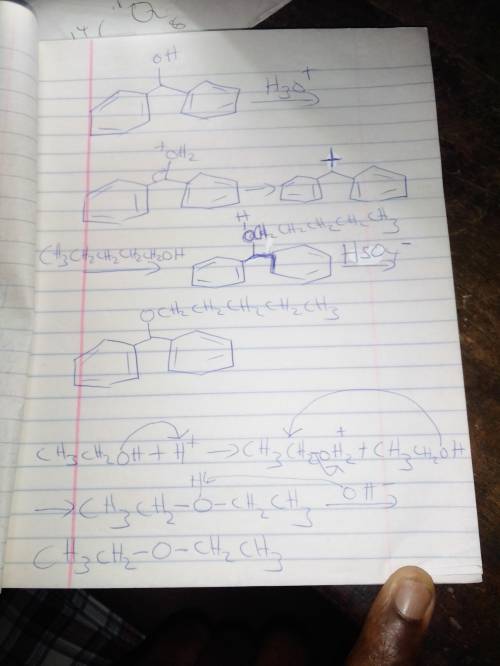
Engineering, 21.12.2020 18:30, student8248
Propyl Benzhydryl Ether (continued on next page):
(1) What volume of 1-pentanol is needed to convert 1.50 grams of benzhydrol to n-pentyl benzhydryl ether?
(2) Based on the results of this experiment, write a mechanism for the acid catalyzed reaction of benzhydrol with 1-pentanol to give the product from the last question. (Note: the mechanism is written on the first page of this experiment. You just have to figure out, based on the experimental results, which alcohol is ROH and which is R'OH and the write it using those two alcohols.)
(3) Under milder temperatures than what is needed for dehydration, strong acids catalyze the self-condensation of 1-propyl alcohol to give di-n-propyl ether. The mechanism differs from that of today's reaction in that the protonated alcohol undergoes an Sy2 rather than an Syl reaction. Write the mechanism for the acid catalyzed condensation of ethyl alcohol to give diethyl ether. Note: make sure your mechanism has the following three steps (a) protonation (b) Sx2 (not Syl) and finally (c) deprotonation.

Answers: 1
Other questions on the subject: Engineering

Engineering, 03.07.2019 23:20, abbz13
Two technicians are discussing the intake air temperature (iat) sensor. technician a says that the computer uses the iat sensor as a backup to the engine coolant temperature (ect) sensor. technician b says that the powertrain control module (pcm) will subtract the calculated amount of fuel if the air measures hot. who is correct
Answers: 3

Engineering, 04.07.2019 18:10, lowkeyqueenk
Apipe with an outside diameter of 15 cm is exposed to an ambient air and surrounding temperature of -20°c. the pipe has an outer surface temperature of 65°c and an emissivity of 0.85. if the rate of heat loss from the pipe surface is 0.95 kw per meter of length, the external convective heat transfer coefficient (h) is: (a) 12.5 w/m"k (b) 18.6 w/mk (c) 23.7 w/mk (d) 27.9 w/mk (e) 33.5 w/mk
Answers: 1

Engineering, 04.07.2019 18:10, ijohnh14
Shafts are machine elements that are used to a) carry axial loads b) direct shear loads c) transmit power d) rotate at constant speed e) none of the above circular and square shafts subjected to the same torque under the same circum behave a) the same way b) almost the same way
Answers: 2

Engineering, 04.07.2019 18:10, soreese02
An ideal otto cycle with air as the working fluid has a compression ratio of 8. the minimum and maximum temperatures in the cycle are 300 k and 1340 k. use constant specific heats at room temperature to determine (a) the amount of heat transferred to the air during the heat- addition kj/kg, (b) the thermal efficiency, and (c) the thermal efficiency of a carnot cycle ope limits. process, in rating between the same temperature
Answers: 2
Do you know the correct answer?
Propyl Benzhydryl Ether (continued on next page):
(1) What volume of 1-pentanol is needed to conver...
Questions in other subjects:


Biology, 22.06.2019 10:30


Health, 22.06.2019 10:30



Biology, 22.06.2019 10:30


English, 22.06.2019 10:30








